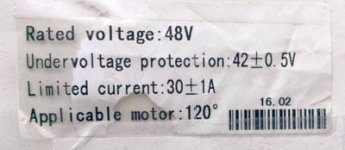^ LOL
The label should kinda be self expanatory if you own such a device, imo, except maybe the 120deg phase, though that one is largely standard among 3 phase brushless motors anyway.
Further explanation? You run the controller @ ~ 48v. Capacitors (which are the limiting factor for voltage) are prob good till ~65v fully charged, so up to 15s lipo/18650 is acceptable, but the low cutoff setting is best utilized for 12s (@ 3.5 avg cell). Programable controllers are way nicer to use a low cutoff for battery, but all batteries with bms already have one anyway so just run a standard pack of 12- 15s.
And limited current means it will draw up to ~30a for whatever motor it is driving , so the battery should be able to produce 30a for at least a short period of time on wot.




